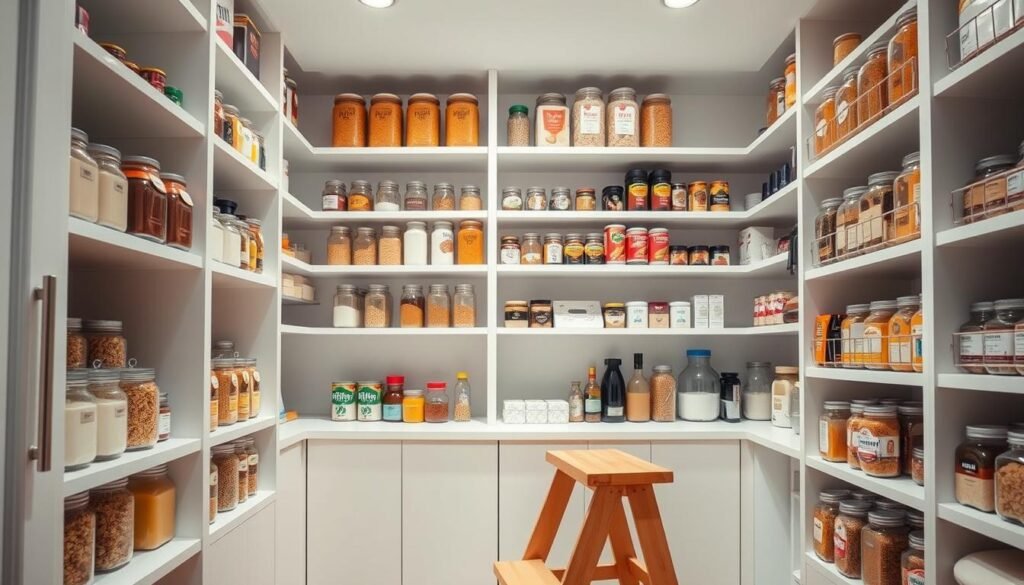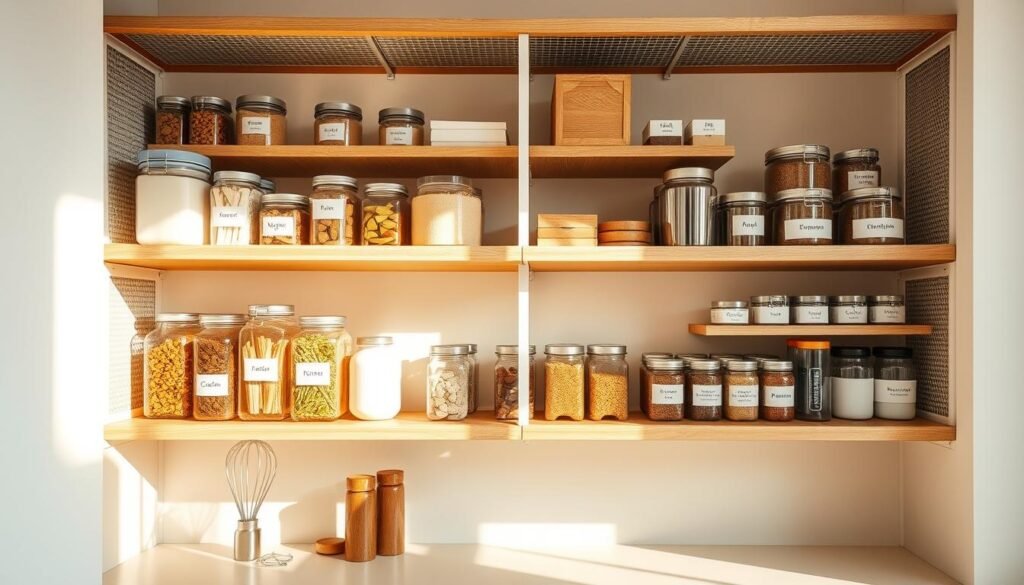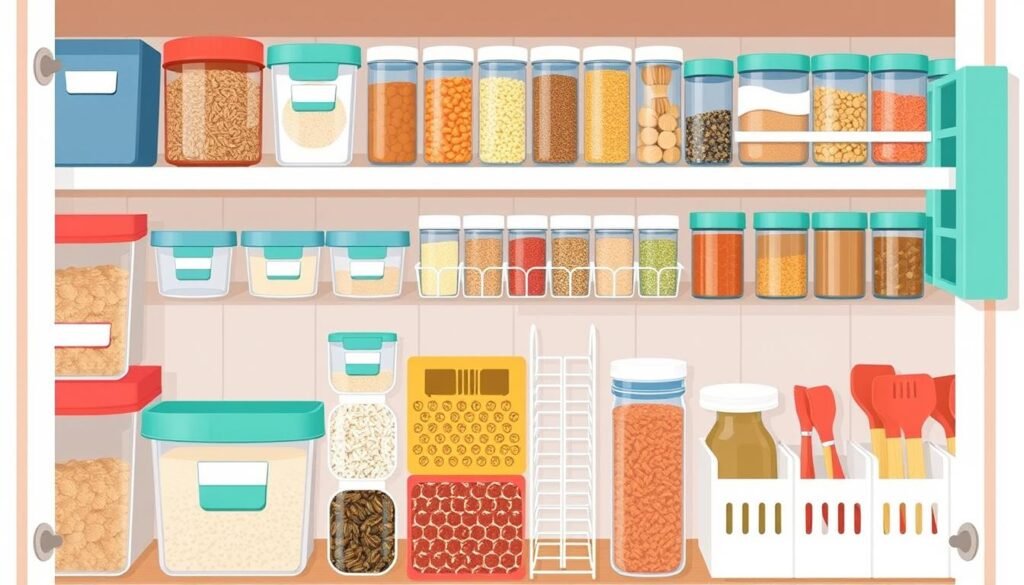
Are you tired of rummaging through a cluttered pantry to find what you need? You’re not alone! Many of us struggle with maximizing our storage space, leading to wasted time and food. An organized pantry is more than just a tidy space; it’s the backbone of an efficient kitchen.
By transforming your pantry into a well-organized space, you’ll save time, reduce food waste, and make meal preparation easier. In this guide, we’ll walk you through practical tips to create a functional and organized pantry that suits your cooking habits and lifestyle.
Key Takeaways
- Assess your current pantry situation to identify areas for improvement.
- Implement smart storage solutions tailored to your needs.
- Maintain your newly organized pantry with simple habits.
- Maximize your pantry’s space with effective organization techniques.
- Create a practical system that works for your cooking habits.
Assessing Your Pantry Space and Needs

The journey to an organized pantry begins with assessing your current space and needs. To start, take a good look at your pantry and think about what works and what doesn’t. Consider the layout, the types of storage you have, and how you currently use the space.
Taking Inventory of Current Items
Begin by taking everything out of your pantry, cabinet, and drawers. Yes, it’s a big task, but it’s essential to understanding what you’re working with. Sort items into categories, such as baking supplies, snacks, and cooking essentials. This will help you see what you have and identify any duplicates or expired items. For instance, you might be surprised at how many expired cans or duplicate spices you have.
Identifying Problem Areas
Now that you have a clear picture of your pantry’s contents, it’s time to identify the problem areas. Are there certain items that are hard to reach? Are there too many things stored in bins or baskets, making it difficult to find what you need? Make a mental note or write down the specific challenges you’re facing. This will help you determine the best solutions for your pantry organization project.
Setting Organization Goals
With a clear understanding of your pantry’s current state, you can start setting organization goals. Think about what you want to achieve with your pantry organization project. Do you want to make it more functional, or are you looking for a more aesthetically pleasing space? Consider your budget for organization supplies, such as bins and clear storage containers. Determine a realistic timeline for your project and think about how you’ll maintain your newly organized pantry.
| Organization Goals | Considerations | Potential Solutions |
|---|---|---|
| Functionality | Accessibility, ease of use | Install shelves, use bins and baskets |
| Aesthetics | Visual appeal, color scheme | Use clear storage containers, labeling system |
| Maintenance | Ease of cleaning, upkeep | Implement a regular cleaning schedule, and use easy-to-clean storage |
Essential Tools for Pantry Organization
Creating an organized pantry starts with having the right tools. You might be wondering what you need to get your pantry in order. The good news is that you don’t have to break the bank or buy a lot of fancy organizers.

Clear Storage Containers
Clear storage containers are a game-changer for pantry organization. They allow you to see exactly what’s inside without having to dig through everything. This makes it easier to find what you need and prevents expired or unwanted items from getting lost in the back of the shelf.
Using clear containers also helps to keep your pantry looking tidy and uniform. You can group similar items, such as pasta, snacks, or canned goods, making it easier to maintain your space.
Bins and Baskets
Bins and baskets are another essential tool for pantry organization. They come in various sizes and can be used to corral small items like snack bags or group similar products together. For example, you can use a bin to store all your baking supplies or snacks in one place.
Using bins and baskets also helps to maximize your pantry’s vertical space. You can stack them on top of each other or place them on shelves to make the most of your storage capacity.
Labeling Systems
A labeling system is crucial for maintaining your newly organized pantry. Labels help you quickly identify what’s inside containers or bins, making it easier to find what you need. You can use adhesive labels, chalkboard labels, or even a label maker to create a system that works for you.
Some key ideas for labeling include using erasable labels for items that change frequently, including expiration dates on labels for perishable items, and creating a consistent labeling system throughout your pantry. This will help keep your pantry organized and make it easier for everyone in the household to find what they need.
Step-by-Step Guide to an Organized Pantry
Let’s dive into the process of turning your cluttered pantry into a well-organized haven. With a few straightforward steps, you can transform your pantry into a space that is not only functional but also a joy to use.
Decluttering and Purging Expired Items
The first step in organizing your pantry is to declutter and purge any expired or unwanted items. Take everything out and sort items into categories, such as expired, donated, and kept. Be ruthless – if it’s expired or you haven’t used it in a year, it’s likely safe to get rid of it. This process will help you understand what you have and what you need to organize.
Grouping Similar Items Together
Once you’ve purged your pantry, group similar items together. This could mean categorizing your items into baking supplies, snacks, canned goods, and so on. By grouping similar items, you’ll make it easier to find what you need when you need it. You can also use this opportunity to check for any duplicates or items that can be consolidated.
Maximizing Vertical Space
To make the most of your pantry space, it’s essential to maximize your vertical storage. This can be achieved by using shelf risers, under-shelf storage, and door storage solutions. By doing so, you’ll be able to fit more items into your pantry without making it feel cluttered.
Shelf Risers and Under-Shelf Storage
Shelf risers can help double your shelf space, while under-shelf storage can be used for storing less frequently used items, such as special occasion dishes or out-of-season cookware. These solutions help keep your pantry organized and make the most of the available space.
Door and Wall Storage Solutions
Utilizing the space on the back of your pantry door or the surrounding walls can provide additional storage for items like spices, bags, or cleaning supplies. Over-the-door storage racks and wall-mounted shelves are great for keeping frequently used items within easy reach.
Special Storage Solutions
Certain items, like spices, canned goods, and snacks, require special storage solutions to keep them organized and easily accessible. Consider using turntables, lazy Susans, and stackable containers to maximize your storage potential.
Spice Organization Systems
A spice organizer can help keep your spices tidy and within reach. Consider a turntable or a wall-mounted spice rack to make the most of your space. This will not only save you time when cooking but also add a touch of elegance to your pantry.
Canned Goods Storage
For canned goods, consider using a tiered storage system or a lazy Susan to make the most of your shelf space. This will allow you to see all your cans at a glance and prevent them from getting lost at the back of the shelf.
Snack and Packet Organization
Snacks and packets can be stored in baskets or containers on shelves or on the back of the door. This keeps them organized and prevents clutter from building up. You can also label the containers to make it easier to find what you’re looking for.
Turntables and Lazy Susans
Turntables and lazy Susans are versatile storage solutions that can be used in various parts of your pantry. They provide easy access to items that would otherwise be hard to reach, making the most of your corner spaces and deep shelves.
By implementing these step-by-step solutions, you’ll be well on your way to creating a pantry that is not only organized but also functional and enjoyable to use. Remember, the key to maintaining your organized pantry is to regularly go through your items and ensure everything is still in its designated place.
Maintaining Your Organized Pantry
Now that you’ve organized your pantry, the real work begins: keeping it that way. You’ve invested time and effort into creating a system that works for you, and it’s essential to maintain it. Labels have been a game-changer for many, helping to keep the pantry organized even when others in the household are using it.
To keep your pantry in top shape, establish simple routines and habits. Regular mini-audits will help prevent expired items from accumulating and keep you aware of what you have on hand. Consider implementing a “one in, one out” rule for specialty ingredients or tools to prevent clutter.
Getting the whole family on board with your organization system is crucial. Please make sure everyone knows where things go, and encourage them to put items back in their designated place. Schedule quarterly deep-cleaning sessions to wipe down containers, check for expired items, and reassess your organization’s system.
By maintaining your organized pantry, you’ll save time and money in the long run by preventing duplicate purchases and food waste. With a little effort, you can enjoy a clutter-free pantry that makes cooking and meal planning a breeze.
FAQ
How do I choose the right storage containers for my kitchen?
When selecting storage containers, consider the size, material, and shape that will best fit your kitchen’s needs. For example, clear containers are great for storing dry goods like rice, pasta, or snacks, while baskets are perfect for holding fruits or vegetables.
What’s the best way to label my storage bins and shelves?
Labeling your storage bins and shelves is crucial for maintaining an organized kitchen. You can use a label maker or write directly on the containers with a marker. Be sure to include the contents and the date stored, if applicable.
How can I maximize the space on my kitchen shelves?
To maximize shelf space, use stackable containers or baskets to store items like canned goods, sauces, or spices. You can also install shelf dividers or baskets to keep items separated and easy to access.
What’s the best way to store spices and seasonings?
Store spices and seasonings in a cool, dry place, away from direct sunlight. Consider using a spice rack or a designated spice drawer to keep them organized and within reach.
How often should I clean and maintain my kitchen storage?
Regularly cleaning and maintaining your kitchen storage is essential to keeping your space organized. Set aside time each week to wipe down shelves, check expiration dates, and tidy up your storage containers.
Can I use baskets to store heavy items like canned goods?
While baskets are great for storing lightweight items, they may not be the best choice for heavy items like canned goods. Consider using sturdy bins or containers that can support the weight and keep your items stable.
How can I keep my kitchen drawers organized?
To keep your kitchen drawers organized, use dividers or inserts to separate utensils, cooking tools, and other items. You can also consider using drawer organizers or dividers specifically designed for kitchen drawers.
